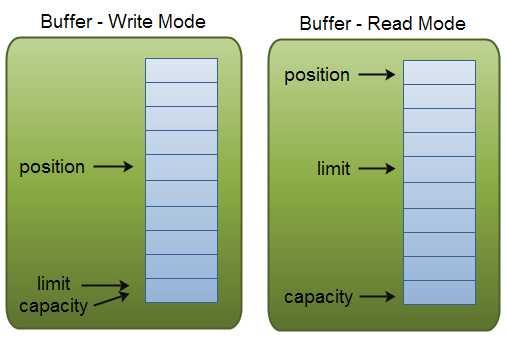标签:失败 cas length .net udp协议 连接失败 exit tac pack
上一篇介绍了五种NIO模型,本篇将介绍Java中的NIO类库,为学习netty做好铺垫
Java NIO 由3个核心组成,分别是Channels,Buffers,Selectors。本文主要介绍着三个部分。
所有的I/O都从一个Channel开始。通道与流不同,通道是双向的,流是单向的。
即可以从通道中读取数据,也可以写数据到通道里 。
读的话,是从通道读取数据到缓冲区,写的话是从缓冲区写入数据到通道。
四种通道:
Java NIO中的Buffer用于NIO通道进行交互。
缓冲区本质上一块可以写入数据,也可以从中读取数据的内存。也就是堆外内存,也叫直接内存。
当向Buffer写入数据时,Buffer会记录下写了多少数据,一旦要读取数据,需要通过flip()方法将Buffer从写模式切换到度模式。
在读模式下,可以读取之前写入到Buffer的所有数据。
一旦读完了所有数据,就需要情况缓存区,让它可以再次被写入。有两种方式能清空缓冲区,调用clear()或者compact()方法。
clear()方法会清空整个缓冲区。compact()方法只会清除已经读过的数据。任何未读的数据都被移到缓冲区的起始处,新写入的数据将放到缓冲区未读数据的后面。
任何未读的数据将被移到缓冲区的起始处,新写入的数据将放大缓冲区未读数据的后面。

Buffer的capacity,position和limit
capacity
capacity作为一个内存块,buffer有一个固定的大小值,也叫capacity,只能向内存中写入byte,long,char等类型。一旦Buffer满了,需要将其清空。
position
当写数据到Buffer中是,position表示当前的位置。初始的position值为0,当一个byte,long等数据写到buffer后,position会向前移动到下一个可插入数据的单元。positon最大可谓capacity-1.
当读取数据时,也是从特定位置读。将Buffer从写模式切换到读模式,positon会被重置0,当从Buffer的position处读取数据时,position向前移动到想一个可以读的位置。
limit
在写模式下,Buffer的limit表示你最多能往Buffer里写多少数据。写模式下,limit等于buffer的capacity
Buffer的分配
要想获得一个Buffer对象首先要进行分配。 每一个Buffer类都有一个allocate方法。下面是一个分配48字节capacity的ByteBuffer的例子。
ByteBuffer buf = ByteBuffer.allocate(48);
Selector(选择器)是Java NIO中能够检测一到多个NIO通道,并能够检测到通道是否为读写事件准备好的的组件。所以Selector可以单个线程处理多个Channel。
Selector能够使用一个线程来处理所有通道。但是对于如今的操作系统和CPU来说,多线程已经较过去效率高了很多。
1.通过调用Selector.open()方法创建一个Selector
2.将Channel注册到Selector上配合使用,可使用Channel.register方法来实现,如下
servChannel.configureBlocking(false); servChannel.register(selector, SelectionKey.OP_ACCEPT);
与Selector一起使用时,Channel必须处于非阻塞模式下。这意味着FileChannel与Selector不能一起使用,因为FileChannel不能切换到非阻塞模式。
3.通道触发意味着该事件已经就绪。Java中有如下常量对应着通道事件。
4.SelectionKey
当向Selector注册Channel时,register()方法会返回一个SelectionKey对象。这个对象包含interest集合,ready集合,Channel,Selector,附加的对象(可选)。
interest集合是你所选择的感兴趣的事件集合。可以通过SelectionKey读写interest集合。
ready 集合是通道已经准备就绪的操作的集合。在一次选择(Selection)之后,你会首先访问这个ready set。
用NIO创建的客户端与服务端:
服务端:
package com.nio; import java.net.InetSocketAddress; import java.nio.ByteBuffer; import java.nio.channels.SelectionKey; import java.nio.channels.Selector; import java.nio.channels.ServerSocketChannel; import java.nio.channels.SocketChannel; import java.util.Date; import java.util.Iterator; import java.util.Set; public class MutipleexerTimeServer implements Runnable{ private Selector selector; private ServerSocketChannel servChannel; private volatile boolean stop = false; /** * 创建多路复用器,绑定NIO端口 * * @param port */ public MutipleexerTimeServer(int port){ try{ selector = Selector.open(); servChannel = ServerSocketChannel.open(); servChannel.configureBlocking(false); servChannel.register(selector, SelectionKey.OP_ACCEPT); servChannel.socket().bind(new InetSocketAddress(port),1024); System.out.println("the time server start at port: "+port ); }catch (Exception e){ e.printStackTrace(); System.exit(1); } } public void stop(){ this.stop = stop; } @Override public void run() { while (!stop){ try { // selector每隔一秒唤醒一次 selector.select(1000); Set<SelectionKey> selectionKeys = selector.selectedKeys(); Iterator<SelectionKey> it = selectionKeys.iterator(); SelectionKey key = null; while (it.hasNext()){ key = it.next(); it.remove(); try { handlerInput(key); }catch (Exception e){ if (key !=null){ key.cancel(); if (key.channel() !=null){ key.channel().close(); } } } } }catch (Exception e){ e.printStackTrace(); } } // 多路复用器关闭后,所有注册到上面的channel和pipe等资源都不被自动去注册并关闭,所有不需要重复释放资源 if (selector!=null){ try { selector.close(); }catch (Exception e){ e.printStackTrace(); } } } private void handlerInput(SelectionKey key) throws Exception{ if (key.isValid()){ // 处理新接入的请求消息 if (key.isAcceptable()){ // Accept the new Connection ServerSocketChannel ssc = (ServerSocketChannel) key.channel(); // 已完成TCP三次握手 SocketChannel sc = ssc.accept(); sc.configureBlocking(false); // Add the new connection to the selector sc.register(selector,SelectionKey.OP_READ); } if (key.isReadable()){ // Read the data SocketChannel sc = (SocketChannel) key.channel(); ByteBuffer readBuffer = ByteBuffer.allocate(1024); int readBytes = sc.read(readBuffer); if (readBytes>0){ readBuffer.flip(); byte[] bytes = new byte[readBuffer.remaining()]; readBuffer.get(bytes); String body = new String(bytes,"UTF-8"); System.out.println("server receive order: "+body); String correntTime = "QUERY".equalsIgnoreCase(body)?new Date(System.currentTimeMillis()).toString():"BAD ORDER"; doWrite(sc,correntTime); }else if (readBytes<0){ // 对端链路关闭 key.cancel(); sc.close(); }else { ; } } } } private void doWrite(SocketChannel channel,String response) throws Exception{ if (response!=null && response.trim().length()>0){ byte[] bytes = response.getBytes(); ByteBuffer writeBuffer = ByteBuffer.allocate(bytes.length); writeBuffer.put(bytes); writeBuffer.flip(); channel.write(writeBuffer); } } } package com.nio; /** * 启动类 */ public class TimeServer { public static void main(String args[]){ int port = 9816; MutipleexerTimeServer timeServer = new MutipleexerTimeServer(port); new Thread(timeServer,"nit").start(); } }
客户端:
package com.nio.client; import java.io.IOException; import java.net.InetSocketAddress; import java.nio.ByteBuffer; import java.nio.channels.SelectionKey; import java.nio.channels.Selector; import java.nio.channels.SocketChannel; import java.util.Iterator; import java.util.Set; /** * @author tangj * @date 2018/6/14 23:13 */ public class TimeClientHandle implements Runnable{ private String host; private int port; private Selector selector; private SocketChannel socketChannel; private volatile boolean stop; public TimeClientHandle(String host,int port){ this.host = host; this.port = port; try{ selector = Selector.open(); socketChannel = SocketChannel.open(); socketChannel.configureBlocking(false); }catch (Exception e){ e.printStackTrace(); System.exit(-1); } } @Override public void run() { try{ doConnect(); }catch (Exception e){ e.printStackTrace(); System.exit(1); } while (!stop){ try{ selector.select(1000); Set<SelectionKey> selectionKeys = selector.selectedKeys(); Iterator<SelectionKey> it = selectionKeys.iterator(); SelectionKey key = null; while (it.hasNext()){ key = it.next(); it.remove(); try { handlerInput(key); }catch (Exception e){ if (key!=null){ key.cancel(); if (key.channel() != null){ key.channel().close(); } } } } }catch (Exception e){ e.printStackTrace(); System.exit(1); } } // 多路复用器关闭后,所有注册到上面的channel和pipe等资源都不被自动去注册并关闭,所有不需要重复释放资源 if (selector!=null){ try { selector.close(); }catch (Exception e){ e.printStackTrace(); } } } private void handlerInput(SelectionKey key) throws Exception{ if (key.isValid()){ // 判断是否连接成功 SocketChannel sc = (SocketChannel) key.channel(); if (key.isConnectable()){ if (sc.finishConnect()) { sc.register(selector, SelectionKey.OP_READ); doWrite(sc); }else { // 连接失败 System.exit(1); } } if (key.isReadable()){ ByteBuffer readBuffer = ByteBuffer.allocate(1024); int readBytes = sc.read(readBuffer); if (readBytes >0){ readBuffer.flip(); byte[] bytes = new byte[readBuffer.remaining()]; readBuffer.get(bytes); String body = new String(bytes,"UTF-8"); System.out.println("NOW IS: "+body); this.stop = true; }else if (readBytes < 0){ // 对端链路关闭 key.cancel(); sc.close(); }else { ; //读到0字节,忽略 } } } } private void doConnect() throws Exception{ // 如果直接连接成功,则注册到多路复用器上,发送请求信息,读应答 if (socketChannel.connect(new InetSocketAddress(host,port))){ socketChannel.register(selector, SelectionKey.OP_READ); doWrite(socketChannel); }else { socketChannel.register(selector,SelectionKey.OP_CONNECT); } } private void doWrite(SocketChannel sc) throws IOException{ byte[] req = "QUERY".getBytes(); ByteBuffer writeBuffer = ByteBuffer.allocate(req.length); writeBuffer.put(req); writeBuffer.flip(); sc.write(writeBuffer); if (!writeBuffer.hasRemaining()){ System.out.println("send order 2 server secceed"); } } } package com.nio.client; /** * @author tangj * @date 2018/6/14 22:56 */ public class TimeClient { public static void main(String args[]){ new Thread(new TimeClientHandle("127.0.0.1",9816)).start(); } }
参考:
并发编程网
《Netty权威指南》
代码地址:
标签:失败 cas length .net udp协议 连接失败 exit tac pack
原文地址:https://www.cnblogs.com/superfj/p/9207294.html